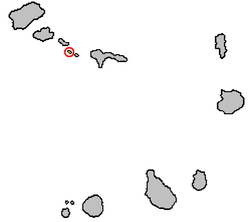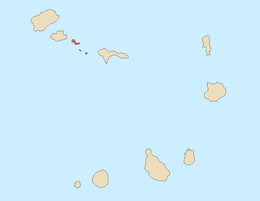Ilhéu Branco

Map of the Cape Verde archipelago showing the position of Branco
|
|
 |
|
| Geography | |
|---|---|
| Location | Atlantic Ocean |
| Coordinates | 16°39′27″N 24°40′51″W / 16.65750°N 24.68083°W |
| Archipelago | Cape Verde |
| Area | 3 km2 (1.2 sq mi) |
| Length | 3.6 km (2.24 mi) |
| Width | 1.4 km (0.87 mi) |
| Highest elevation | 327 m (1,073 ft) |
| Administration | |
|
Cape Verde
|
|
| Concelhos (Municipalities) | São Vicente |
Ilhéu Branco is an uninhabited 300 ha islet in the Barlavento group of the Cape Verde archipelago off the coast of north-west Africa in the Atlantic Ocean. Branco is flanked by the islands of Santa Luzia to the north-west and by Raso to the south-east. Since 1990, the islet forms a part of a protected area as Raso-Branco Strict Nature Reserve established in 1990.
The etymology is Portuguese for "white islet" due to its guano deposits.
Branco is a large rectangular rock, less than 4 km long by more than 1 km wide, rising steeply to a ridge running the length of the island, with a maximum height of 327 m. Its summit is lower to that of Santa Luzia's but higher than Raso. Seas around the island are usually rough throughout the year, making access difficult.
The geology includes holocene rocks, alluvial deposits and aeolian dunes.
The islet's climate is dry, rainfall occur between August and November. Temperatures is 25 °C in the summer and 20 °C in the winter.
The seamount was formed in around 124 million years ago from the older ocean crust during the Cretaceous Period.
During the Ice Age, Santa Luzia along with São Vicente and Santo Antao were a part of the Northwestern Island which was the size of about 1,500 km2. Around 6,000 to 5,000 BC, the island split and was likely part of Santa Luzia and split to form Ilhéu Branco after sea levels rose in the Late Ice Age.
The island was discovered in around 1462 and gave its islet name due to its guano deposits.
Flora especially those on the endangered list include Limonium brunneri.
The Cape Verde giant skink, which only occurred on Branco and Raso, has not been seen since the early twentieth century and is considered extinct. It is thought to have been wiped out through over-exploitation by humans for its skin and for food. The Cape Verde giant gecko (Tarentola gigas) is still present. The island has been identified as an Important Bird Area (IBA) by BirdLife International because it supports 2500–3570 breeding pairs of Cape Verde shearwaters as well as peregrine falcons, Iago sparrows and the Cape Verdean barn owls (Tyto detorta).
...
Wikipedia
